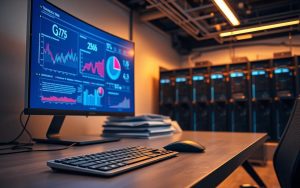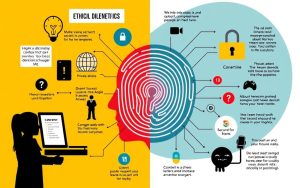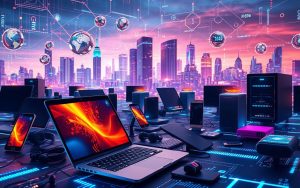Information technology (IT) combines hardware, software, and networks to manage data effectively. It plays a vital role in modern business strategies and societal advancements. By streamlining processes, IT enhances productivity and fosters innovation across industries.
From faster decision-making to global connectivity, IT supports efficient information dissemination. It ensures secure data storage and seamless communication. Businesses rely on IT to stay competitive and meet evolving customer demands.
This article explores 18 transformative IT services that drive progress. Each service contributes to improved efficiency, security, and innovation. Discover how IT shapes the future of business and everyday life.
Introduction to Information Technology
Modern IT systems rely on hardware, software, and networking to drive efficiency. These components work together to create functional ecosystems that support business workflows and data management.
Hardware includes physical devices like servers, computers, and biometric tools. Over time, it has evolved from basic machines to advanced systems capable of handling complex tasks. This evolution has enabled faster processing and improved user experiences.
Software plays a crucial role in enabling hardware functionality. It includes programs and applications that process data and execute tasks. From operating systems to specialized tools, software ensures seamless operations across devices.
Networking connects devices and enables communication. It supports cloud services, allowing businesses to store and access data remotely. Reliable networking infrastructure is essential for maintaining productivity and security.
Here are some key statistics highlighting the impact of IT components:
| Component | Market Projection |
|---|---|
| Software as a Service (SaaS) | $232 billion by 2024 |
| Gaming Industry | $347 billion in 2022 |
These figures underscore the growing reliance on IT systems. Businesses continue to invest in hardware, software, and networking to stay competitive and meet customer demands.
Cloud Computing
Cloud computing revolutionizes how businesses access and manage resources. Unlike traditional on-premise infrastructure, it relies on remote servers to deliver scalable solutions. This approach reduces costs and enhances flexibility for organizations of all sizes.
With cloud computing, companies can avoid the hassle of maintaining physical hardware. Instead, they access virtualized resources on demand. This shift has transformed industries by enabling faster innovation and improved efficiency.
Cloud services are categorized into three main models: Infrastructure as a Service (IaaS), Platform as a Service (PaaS), and Software as a Service (SaaS). Each model caters to specific business needs, offering unique advantages.
Infrastructure as a Service (IaaS)
IaaS provides virtualized computing resources over the internet. Examples include AWS EC2 and Google Compute Engine. Businesses can scale resources up or down based on demand, ensuring cost-effectiveness.
Platform as a Service (PaaS)
PaaS offers development platforms for building and deploying applications. Microsoft Azure and Heroku are popular examples. This model simplifies the development process, allowing teams to focus on coding rather than infrastructure management.
Software as a Service (SaaS)
SaaS delivers ready-to-use applications via the cloud. Google Workspace and Salesforce are prominent examples. Users can access these applications from any device, ensuring global accessibility and collaboration.
Cloud computing offers significant benefits, including a 60-80% cost reduction compared to legacy systems. It also provides unparalleled scalability and accessibility, making it a cornerstone of modern business strategies.
| Service Model | Key Features | Examples |
|---|---|---|
| IaaS | Virtualized resources, scalability | AWS EC2, Google Compute Engine |
| PaaS | Development platforms, streamlined coding | Microsoft Azure, Heroku |
| SaaS | Ready-to-use applications, global access | Google Workspace, Salesforce |
Augmented Reality (AR)
Augmented Reality (AR) integrates digital elements into physical environments, transforming user experiences. Unlike Virtual Reality (VR), which creates fully immersive worlds, AR enhances real-world settings by overlaying virtual data. This technology is reshaping various industries, from gaming to healthcare.
In gaming, AR brings interactive experiences to life. Pokémon GO is a prime example, blending virtual creatures with real-world locations. Retailers also leverage AR for virtual try-ons, such as the IKEA Place app, which lets users visualize furniture in their homes.
Enterprise applications of AR are equally impactful. In manufacturing, remote expert assistance through AR-enabled devices streamlines maintenance processes. Boeing, for instance, reported a 25% faster assembly time using AR manuals.
The AR glasses market is projected to grow at a 35% CAGR through 2027, driven by advancements in technologies. This growth highlights AR’s potential to revolutionize how businesses operate and interact with their environments.
Blockchain
Blockchain technology redefines secure data management through decentralized systems. It creates tamper-proof records, ensuring transparency and trust in digital transactions. Beyond cryptocurrency, blockchain is transforming industries like supply chain and healthcare.
In supply chain management, blockchain reduces fraud, saving businesses an estimated $50 billion annually. Walmart, for example, uses blockchain to trace food products, enhancing safety and efficiency. This technology ensures every step in the process is recorded and verifiable.

Smart contracts, powered by platforms like Ethereum, automate agreements without intermediaries. These self-executing contracts streamline business processes, reducing costs and errors. They are particularly useful in industries requiring precise and secure transactions.
However, blockchain faces challenges, particularly in energy consumption. Bitcoin mining alone uses around 150 TWh of electricity annually. Efforts are underway to develop more sustainable blockchain solutions to address this issue.
The financial sector is rapidly adopting blockchain, with 48% of banks integrating it into their systems by 2023. This adoption enhances transaction speed, security, and transparency. Additionally, non-fungible tokens (NFTs) have emerged as a $25 billion market, showcasing blockchain’s versatility beyond traditional applications.
Blockchain’s decentralized nature ensures that data remains secure and tamper-proof. Its applications continue to grow, reshaping industries and improving processes. As businesses embrace this technology, blockchain is set to play a pivotal role in the future of digital innovation.
Quantum Computing
Quantum computing leverages qubits to achieve unparalleled processing power. Unlike classical bits, which represent either 0 or 1, qubits exist in superposition states. This allows them to perform multiple calculations simultaneously, revolutionizing data processing.
One groundbreaking application is Shor’s algorithm, which threatens RSA encryption. By factoring large numbers exponentially faster, it could render current cryptographic systems obsolete. This highlights the transformative potential of quantum technology.
In the pharmaceutical industry, quantum computing accelerates drug discovery. It simulates molecular interactions with precision, enabling faster development of life-saving medications. IBM’s 433-qubit Osprey processor is a prime example of this capability.
Quantum supremacy, demonstrated by Google in 2019, marked a significant milestone. Their quantum computer solved a problem in 200 seconds that would take classical supercomputers thousands of years. This achievement underscores the immense potential of quantum processing.
However, challenges remain. Quantum computers require near-absolute zero temperatures to function, making them costly and complex to maintain. Despite these hurdles, advancements continue to push the boundaries of what’s possible.
Edge Computing
Edge computing transforms how data is handled by processing it closer to the source. Unlike traditional cloud computing, which relies on centralized servers, edge computing minimizes latency by performing processing tasks near the devices generating the data. This approach is critical for applications requiring real-time responses, such as IoT and autonomous vehicles.
One of the key advantages of edge computing is its ability to reduce latency. While cloud computing typically experiences delays of around 100ms, edge computing achieves response times as low as 10ms. This improvement is essential for industries like manufacturing, where real-time efficiency is crucial.
The synergy between edge computing and 5G networks is driving innovation. Together, they enable real-time factory automation and enhance the capabilities of smart cities. For example, Tesla’s in-car AI processes up to 5,000 frames per second using edge computing, ensuring rapid decision-making for autonomous driving.
The market for edge computing is growing rapidly. From $15 billion in 2022, it is projected to reach $44 billion by 2027. This growth reflects the increasing adoption of edge solutions across various sectors.
Security is another significant benefit of edge computing. By processing data locally, it reduces the risk of breaches during transmission to centralized servers. This localized approach ensures sensitive information remains protected.
| Feature | Edge Computing | Cloud Computing |
|---|---|---|
| Latency | 10ms | 100ms |
| Data Processing | Local | Centralized |
| Security | Enhanced | Moderate |
5G Technology
5G technology is reshaping connectivity with unprecedented speed and reliability. Offering peak speeds of 20Gbps and latency as low as 1ms, it enables real-time communication and advanced applications. From smart cities to remote surgery, 5G is transforming how industries operate.
Compared to 4G, 5G is 100 times faster, making it a game-changer for devices and network performance. However, millimeter wave technology, a key component of 5G, faces challenges due to its short range. This requires denser infrastructure, with 5G needing three times more towers than 4G networks.
In industrial settings, 5G-powered IoT solutions have reduced factory downtime by 90%. This efficiency boost is critical for industries relying on real-time data processing. Healthcare is also benefiting, with telesurgery trials in China showcasing the potential of 5G-enabled remote procedures.
- Speed: 20Gbps peak speeds for seamless connectivity.
- Latency: 1ms response time for real-time applications.
- Infrastructure: Requires three times more towers than 4G.
- Applications: Smart cities, industrial IoT, and healthcare innovations.
As 5G continues to roll out globally, its impact on communication and industries will only grow. This technology is paving the way for a more connected and efficient future.
Cybersecurity Solutions
Cybersecurity solutions are essential for protecting modern digital ecosystems. With the global market projected to reach $424 billion by 2030, businesses are investing heavily in advanced security measures. These solutions safeguard sensitive data and ensure the integrity of critical systems.

Zero-trust frameworks are gaining traction as a cornerstone of modern cybersecurity strategies. This approach requires continuous verification and limits access to only what is necessary. By adopting zero-trust principles, organizations can minimize vulnerabilities and enhance their overall security posture.
AI-powered threat detection is revolutionizing how businesses respond to cyber threats. Platforms like AI-driven Security Operations Centers (SOCs) can analyze up to 1 million events per second. This capability enables rapid identification and mitigation of potential risks, ensuring proactive protection.
Ransomware remains a significant threat, with payments totaling $20 billion in 2023. Attackers are using increasingly sophisticated methods to evade detection and maximize impact. Implementing robust backup systems and employee training can help mitigate these risks.
Multi-factor authentication (MFA) is now a standard practice, with 80% of enterprises adopting it. MFA adds an extra layer of security by requiring multiple forms of verification. This simple yet effective measure significantly reduces the risk of unauthorized access.
Regulatory compliance is another critical aspect of cybersecurity. Non-compliance with frameworks like GDPR can result in fines of up to 4% of a company’s revenue. Staying updated with regulations ensures businesses avoid penalties and maintain trust with customers.
Best practices include establishing a 15-minute breach containment SLA. Quick response times are crucial for minimizing damage and restoring normal operations. For more insights on cybersecurity solutions, explore additional resources.
Robotic Process Automation (RPA)
Robotic Process Automation (RPA) streamlines repetitive tasks, boosting operational efficiency. This software technology automates manual processes, enabling businesses to focus on strategic initiatives. With a market growing at a 38% CAGR, RPA is reshaping industries worldwide.
Leading platforms like UiPath and Automation Anywhere dominate the RPA landscape. They excel in tasks such as invoice processing and HR automation. These solutions reduce costs by up to 70% in back-office operations, making them indispensable for modern businesses.
RPA’s integration with cognitive technologies like Natural Language Processing (NLP) and Machine Learning (ML) enhances its capabilities. This combination allows for more complex task automation, such as analyzing unstructured data and making intelligent decisions.
One of RPA’s standout features is its accuracy. With a 92% success rate, it outperforms human error rates of 80%. In healthcare, RPA automates prior authorization processes, reducing delays and improving patient care.
However, implementing RPA comes with challenges. Poor planning leads to a 40% failure rate. Organizations must invest in proper training and strategy to maximize RPA’s potential.
| Benefit | Impact |
|---|---|
| Cost Reduction | Up to 70% in back-office tasks |
| Accuracy | 92% vs. human 80% |
| Healthcare Use | Automates prior authorization |
Natural Language Processing (NLP)
Natural Language Processing (NLP) bridges the gap between human language and machines. This advanced software technology enables computers to understand, interpret, and generate human language. With the NLP market projected to reach $49 billion by 2027, its impact is undeniable.

Breakthroughs in transformer architecture have revolutionized NLP. Models like ChatGPT, with 175 billion parameters, showcase the potential of this technology. These advancements allow for real-time translation tools and more accurate language understanding.
Sentiment analysis is a key application of NLP. It helps brands monitor customer feedback with 90% accuracy. By analyzing emotions in text, businesses can improve their products and services.
In healthcare, NLP is transforming clinical workflows. It automates clinical note summarization, saving time for medical professionals. This ensures accurate and efficient data processing in critical environments.
Voice commerce is another growing field powered by NLP. By 2025, it is expected to reach $80 billion. Voice assistants and smart speakers are making shopping more accessible and convenient.
However, NLP faces ethical challenges. Bias in language models can lead to unfair outcomes. Techniques like bias mitigation are essential to ensure fairness and inclusivity in NLP applications.
“NLP is not just about understanding language; it’s about understanding people.”
As NLP continues to evolve, its applications will expand across industries. From healthcare to commerce, this technology is reshaping how we interact with machines and each other.
Virtual Reality (VR)
Virtual Reality (VR) immerses users in digital environments, transforming how we interact with technology. From gaming to employee training, VR offers groundbreaking solutions for modern challenges. The VR market is projected to reach $62 billion by 2027, reflecting its growing impact across industries.
Consumer and enterprise VR serve distinct purposes. While gaming dominates consumer applications, enterprises use VR for simulations and training. Walmart, for example, employs 17,000 Meta Quest 3 headsets to enhance employee onboarding and efficiency.
In healthcare, VR is revolutionizing treatment methods. PTSD exposure therapy uses VR to create controlled environments for patients. This approach has shown significant success in reducing symptoms and improving mental health outcomes.
Industrial design also benefits from VR. Ford uses virtual prototyping to test vehicle designs before physical production. This method reduces costs and accelerates development cycles, showcasing VR’s practical applications.
Education is another area where VR shines. Studies show that VR-based learning improves retention rates by 30%. Students can explore historical sites or conduct virtual experiments, making education more engaging and effective.
Despite its advantages, VR faces hardware challenges. Around 50% of users report motion sickness, limiting prolonged use. Addressing these issues is crucial for broader adoption and improved user experience.
“VR is not just a tool; it’s a gateway to new possibilities in learning, healing, and innovation.”
As VR technology evolves, its applications will continue to expand. From healthcare to education and beyond, VR is reshaping how we interact with the world around us.
Edge AI
Edge AI merges machine learning with edge computing for real-time solutions. This innovative approach enables devices to process data locally, reducing latency and improving efficiency. From facial recognition to predictive maintenance, Edge AI is transforming industries.

TinyML frameworks are revolutionizing microcontrollers, making them capable of running machine learning models. These frameworks allow for real-time processing on low-power devices, enabling applications like smart cameras to detect objects in just 200 milliseconds.
In manufacturing, Edge AI achieves 99% accuracy in defect detection. This ensures higher product quality and reduces waste. By analyzing data locally, manufacturers can respond instantly to issues, improving overall efficiency.
Privacy is another significant benefit of Edge AI. Since data is processed locally, sensitive information never leaves the device. This minimizes the risk of breaches and ensures compliance with privacy regulations.
However, Edge AI faces challenges, particularly in model compression. Techniques like quantization and pruning are essential to fit complex models onto resource-constrained devices. These methods ensure that Edge AI remains practical and scalable.
As Edge AI continues to evolve, its applications will expand across industries. From smart cities to healthcare, this technology is paving the way for smarter, more efficient solutions.
DevOps Practices
DevOps practices bridge the gap between development and operations for seamless workflows. By fostering collaboration, DevOps enhances efficiency and accelerates software delivery. This approach integrates continuous integration and deployment (CI/CD) pipelines, ensuring faster and more reliable releases.
Shift-left testing is a key DevOps practice. It identifies and resolves bugs early in the development cycle, reducing defects by up to 40%. This proactive approach minimizes delays and ensures higher-quality software.
GitOps simplifies Kubernetes cluster management. It uses Git repositories as the single source of truth for infrastructure and application configurations. This method enhances transparency and reduces errors in deployment processes.
DevOps also improves incident response times. Metrics like Mean Time to Recovery (MTTR) have dropped from 4 hours to just 15 minutes. This ensures faster resolution of issues and minimizes downtime.
Security is integrated into DevOps through DevSecOps. By embedding security checks into CI/CD pipelines, organizations can identify vulnerabilities early. This approach ensures secure and compliant systems.
Popular tools like Jenkins, Docker, and Terraform are essential for DevOps success. Jenkins automates CI/CD pipelines, Docker enables containerization, and Terraform manages infrastructure as code. These tools streamline processes and enhance scalability.
| Tool | Function |
|---|---|
| Jenkins | Automates CI/CD pipelines |
| Docker | Enables containerization |
| Terraform | Manages infrastructure as code |
DevOps adoption increases deployment frequency by 200x. This transformation ensures businesses stay competitive in fast-paced markets. By embracing DevOps, organizations achieve faster, more reliable, and secure software delivery.
Conclusion
Advancements in information technology continue to redefine how businesses operate and innovate. From cloud computing to quantum-safe cryptography, these technologies drive efficiency and resilience. As IT spending is projected to reach $5 trillion by 2024, organizations must prioritize robust systems and security measures to stay competitive.
Emerging trends like edge AI and sustainable IT solutions highlight the industry’s focus on the future. Cybersecurity remains a cornerstone, ensuring data protection in an increasingly digital world. Continuous upskilling for IT professionals is essential to harness these innovations effectively.
By embracing these advancements, businesses can achieve long-term growth and contribute to global sustainability goals. The journey of digital transformation is ongoing, and staying ahead requires adaptability and forward-thinking strategies.







